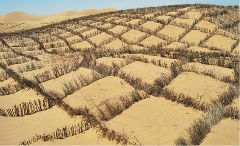UN: China’s success against soil loss could be replicated
2017-09-07
China Daily
China’s success in fighting desertification, or soil loss, is a model that can be replicated in other parts of the world, delegates to a United Nations conference said on Sept 6.
“The achievements of China are very encouraging because many of the successful projects are launched in the country’s poorest areas with low technology,” said Monique Barbut, secretary-general of the United Nations Convention to Combat Desertification.
“China’s examples are comparable to other situations in the world, and we could introduce them somewhere else.”
The UNCCD opened a conference in Ordos, the Inner Mongolia autonomous region, on Sept 6, which is expected to establish a strategic framework on land degradation for 2018-30.
Erik Solheim, deputy secretary-general of the UN and executive director of the UN Environment Programme, also spoke highly of Ordos’ commitment to the greening of the vast Kubuqi Desert, saying its experience in developing ecological economies in desert conditions is invaluable for other regions and countries facing desertification.
He encouraged other regions and countries that are ravaged by sand and dust - Africa, the Middle East and Latin America - to adopt Ordos’ Kubuqi model.
In 2002, China became the first country to issue a law on the prevention and control of desertification. It has also carried out projects to curb desertification, including the Three-North Shelter Forest Program and the Beijing-Tianjin Sand Source Control Project.
According to the State Forestry Administration, the area of desertified land in the country shrank by an average 1,980 square kilometers annually from 2010 to 2014.
Inner Mongolia, which is covered by large areas of sand, accounts for 23 percent of China’s desertified land. However, forest coverage increased by more than a percentage point to 21 percent last year, according a national forest resources survey.
The region now tops the country with 248,667 sq km of forests, an increase of 12,015 sq km since the previous national survey was released in 2014. By 2020, about 40 percent of the region’s sandy land will be improved, and wetlands are expected to exceed 60,000 sq km, according to the administration.
“We have always given top priority to the prevention and control of desertification and the improvement of the environment, because they are the key to sustainable development,” said Bu Xiaolin, chairwoman of the Inner Mongolia autonomous region.
She said that the local government has established 182 natural reserves, three global geoparks, along with 100 national-level forest parks, wetland parks and geoparks. It also has been optimizing ecological forestry development by planting Scots pine trees in Hulunbuir, Horqin and the Maowusu Desert.


